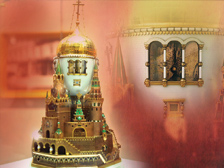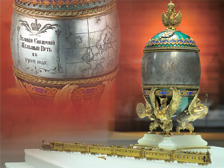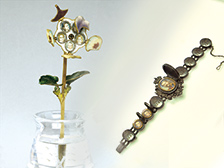
Magnificent minutiae:
Peer inside the window of this Easter egg to see surprisingly detailed furnishings of the church inspired by the Cathedral of the Assumption.
Magnificent minutiae:
Peer inside the window of this Easter egg to see surprisingly detailed furnishings of the church inspired by the Cathedral of the Assumption.

Coveted commute:
Made in 1900, the Trans-Siberian Train Easter Egg commemorates the construction of the world’s longest railway.
Coveted commute:
Made in 1900, the Trans-Siberian Train Easter Egg commemorates the construction of the world’s longest railway.

Picture perfect:
Miniature portraits were popular at the time, often incorporated into wedding anniversary gifts from Russian kings to their queens.
Picture perfect:
Miniature portraits were popular at the time, often incorporated into wedding anniversary gifts from Russian kings to their queens.
Fabergé eggs encapsulate history
February 24, 2013
Inimitable Easter eggs Peter Carl Fabergé created for Russia’s royalty from the late 19th to the early 20th century are not only gemological masterpieces. They also reveal historic details of Russia’s last dynasty. Four of these priceless pieces are now on show at the Fabergé: Legacy of Imperial Russia exhibition at the Hong Kong Heritage Museum, the largest display of Russian artefacts in Hong Kong.
The exhibition spotlights more than 200 items, each a testament to its craftsman’s prowess. Of the 50 Easter eggs leading jeweller and goldsmith Fabergé created for the royal family from 1885 to 1917, 42 are known to have survived.
Easter is the most important date on the Russian Orthodox calendar. It was customary to exchange eggs at this time. Fabergé’s eggs astonished and delighted the royal family with their attention to detail. Each egg also depicted a different event or theme in Russia’s history.
The “Moscow Kremlin” Easter Egg was an Easter gift from Tsar Nicholas II to his wife in 1906, created in memory of their visit to the old capital in 1903.
Made of gold, silver, onyx, glass and other materials, the egg is divided into two parts. The structure that supports the egg has four Kremlin turrets. The egg, with its white enamel surface and gold dome, was inspired by the Cathedral of the Assumption, where all tsars were married and crowned.
Surprises inside
Heritage Museum Assistant Curator Sunny Tang reminds exhibition visitors to peer closely inside the “Moscow Kremlin” egg.
"We have installed a spotlight outside the transparent display box, so viewers can see the details inside from the window of the church."
This egg holds another surprise: A music box inside the gold turret-and-wall structure plays two traditional Easter hymns.
"The music box still functions. I was lucky to hear how it sounds when the curator of the Moscow Kremlin Museums demonstrated it to us using the gold key," Mr Tang said.
The Trans-Siberian Train Easter Egg was made in 1900 to commemorate the construction of the Trans-Siberian Railway, the world’s longest railway. A route map is engraved across the face of the egg, with major stations marked by a precious stone. Inside is a miniature train crafted of platinum and gold which can be set in motion using a tiny gold key to wind the mechanism.
The "Memory of Azov” Easter Egg also has a built-in surprise: a miniature replica of the Imperial Russian Navy cruiser. It is skilfully executed down to the smallest details including tiny platinum boats, anchors on chains, and cobweb-thin golden ropes on masts. The egg commemorates the journey Tsar Alexander III’s sons took to the Far East, including Hong Kong, in 1890-91.
The unfinished "Constellation Tsarevich" Easter Egg was made to commemorate crown prince Tsarevich Alexei. He was the family's main hope for the dynasty’s continuation. The outbreak of the Russian Revolution marked the end of the Romanov royal family, though. The egg’s upper half is a dark blue cobalt glass orb displaying Northern Hemisphere constellations, and the stars on it were to be made of diamonds.
Picture perfect
The valuable collection reflects not only the royal family’s magnificent style, but also the love and care the tsar showered on his family.
A gift from Tsar Alexander II to his wife to commemorate their 25th wedding anniversary was a bracelet comprised of nine oval portraits of himself and their eight children.
On their 10th wedding anniversary, Tsar Nicholas II presented a gift named "Pansies" to the queen. It is a special bouquet of pansies sparkling with gold and diamonds. Lifting its petals reveals miniature portraits of their five children framed with diamonds.
The 270 works in the exhibit are on loan from the collections of the Moscow Kremlin Museums and the Fersman Mineralogical Museum of Russia. Religious objects are also on show, such as an icon of the Virgin Mary and baby Jesus, both tiled with white pearls to represent purity.
Eye-catching treasures from non-royals share the spotlight, such as silverware items, adornments and toys. A video depicting Fabergé’s art and the rise and fall of the House of Fabergé is screened in the gallery. Workshops, lectures and docent tours will run during the exhibition period, which ends on April 29.
Click
here for details.